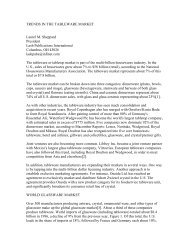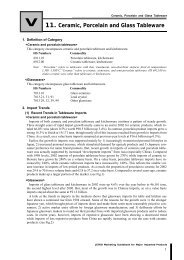eu market survey 2003 - crecer
eu market survey 2003 - crecer
eu market survey 2003 - crecer
You also want an ePaper? Increase the reach of your titles
YUMPU automatically turns print PDFs into web optimized ePapers that Google loves.
White with minimalist lines remains the distinctive feature of porcelain, according the Ambiente.<br />
At the moment, shades of green, lilac-pink and yellow are the most important colours. Luxury is<br />
also becoming more important in this segment.<br />
Cutlery<br />
The EU-cutlery <strong>market</strong> represented a value of over € 2 billion in 2002. France is the EU’s leading<br />
cutlery consumer. In 2002, France accounted for 37 percent of the total cutlery sales in the EU. At<br />
a considerable distance, we find Germany and Italy. Looking at the per capita expenditure, the<br />
French are by far the biggest consumers of cutlery. In 2002, they spent about € 12.76 per capita,<br />
almost three times as much as the Italians.<br />
There are basically two <strong>market</strong>s for cutlery, that of classic high quality cutlery, mostly sold in<br />
sets, and casual cutlery for everyday use, generally sold by piece. Everyday cutlery can itself be<br />
divided into two segments: conventional and fashion-oriented cutlery. Everyday cutlery, in<br />
general, should be inexpensive whereas fashion-oriented pieces can command somewhat higher<br />
prices. A good example of this is cutlery with fashionable coloured handles, which has been<br />
popular for several years following a trend towards matching kitchenware. This type of cutlery,<br />
although also sold by piece, is sometimes presented in simple sets of four or six on a stand. This<br />
type of novelty provides manufacturers and retailers with added-value in a generally low-value<br />
sector.<br />
High-quality cutlery can also be divided into<br />
two segments: stainless steel plated cutlery,<br />
and cutlery made of precious metals, mainly<br />
silver. The top end of the <strong>market</strong> is completely<br />
dominated by famous brands. This type of<br />
cutlery is purchased once in a lifetime and the<br />
purchases are seen as an investment. This<br />
segment however is shrinking, mainly because<br />
of reasonable quality and low prices of the<br />
first segment.<br />
A key development is the popularity of<br />
kitchen knives, which have become<br />
professional-style products. Knife-sets have<br />
become a popular item in the kitchen today.<br />
According to the Ambiente, linear and<br />
functional designs dominate the cutlery<br />
<strong>market</strong>, with stainless steel being the material<br />
of choice. New materials, like titanium are<br />
starting to be used to enhance the appeal.<br />
Figure 3.9<br />
14<br />
12<br />
10<br />
8<br />
6<br />
4<br />
2<br />
0<br />
12.76<br />
France<br />
Consumer expenditures on Cutlery<br />
(per year in € per capita), in the EU,<br />
1998-2002<br />
Italy<br />
4.34 4.1 4.05<br />
Germany<br />
Netherlands<br />
Spain<br />
1998<br />
2000<br />
2002<br />
3.15 2.89<br />
United<br />
Kingdom<br />
Source: Euromonitor, <strong>2003</strong><br />
Metalware<br />
There are no figures available concerning the consumption of metalware in the EU. In the<br />
previous paragraph, we have given some extrapolation concerning the <strong>market</strong> size in the different<br />
countries in this <strong>survey</strong>. The extrapolations indicate that North European countries (United<br />
Kingdom, Germany and the Netherlands) consume relatively more metalwares. This can be<br />
explained by the fact that metal pots and pans are the main food preparing items in these<br />
countries, whereas in Italy and Spain, people use more ceramic and glass cook- and ovenware.<br />
According to Euromonitor, the metalware <strong>market</strong> can be divided into to two segments. Firstly, it<br />
consists of metal products which are more table-orientated, like for example bread-baskets. The<br />
second segment consists of metal products which are used in the preparation of food, like cook-,<br />
oven- and bakeware. This segment accounted for more than three-quarters of the <strong>market</strong> for<br />
metallic table- & kitchenware. The way people prepare their food largely determines the<br />
22





